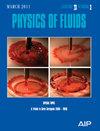Experimental study on flow field and performance of bionic-wavy leading edge in an axial compressor with positive bowed blades
IF 4.1
2区 工程技术
Q1 MECHANICS
引用次数: 0
Abstract
To enhance the aerodynamic performance of compressors in advanced aeroengines, a compound flow control method combining positively bowed blades and bionic-wavy leading edges is proposed for improving the aerodynamic performance of compressor cascades with controlled diffusion airfoils. This study verified the effectiveness of the compound control method through low-speed wind tunnel experiments using five-hole probe measurements and surface oil-flow visualization techniques. Additionally, the flow field structure was analyzed, and vortex models were established to thoroughly discuss the mechanism of the compound flow control method. The results show that within the incidence angle range of 0°–4° studied in this paper, the composite control method achieved significantly effective control, with a maximum reduction in overall total pressure loss of 25.8% compared to straight blade cascades. Three vortex models were established. The positive bowed blade cascade induced a complex vortex structure in the concentrated shedding vortex region, increasing losses in the concentrated shedding vortex (CSV) region but reducing profile losses. The coupled method further reduced profile losses and optimized the flow field in the CSV region. This study not only validates the feasibility of the compound method but also provides guidance for applying flow control methods to bowed blade cascades.带正弓形叶片的轴流式压缩机中仿生波浪前缘的流场和性能实验研究
为了提高先进航空发动机中压缩机的气动性能,提出了一种结合正弓形叶片和仿生波浪形前缘的复合流控制方法,以改善采用可控扩散翼面的压缩机级联的气动性能。本研究利用五孔探针测量和表面油流可视化技术,通过低速风洞实验验证了复合控制方法的有效性。此外,还分析了流场结构,建立了涡流模型,深入探讨了复合流控制方法的机理。结果表明,在本文研究的 0°-4° 入射角范围内,复合控制方法取得了显著的控制效果,与直叶片级联相比,总压力损失最大减少了 25.8%。本文建立了三种涡流模型。正弓形叶片级联在集中脱落漩涡区域诱发了复杂的漩涡结构,增加了集中脱落漩涡(CSV)区域的损失,但减少了剖面损失。耦合方法进一步降低了剖面损失,优化了 CSV 区域的流场。这项研究不仅验证了复合方法的可行性,还为将流动控制方法应用于弓形叶片级联提供了指导。
本文章由计算机程序翻译,如有差异,请以英文原文为准。
求助全文
约1分钟内获得全文
求助全文
来源期刊

Physics of Fluids
物理-力学
CiteScore
6.50
自引率
41.30%
发文量
2063
审稿时长
2.6 months
期刊介绍:
Physics of Fluids (PoF) is a preeminent journal devoted to publishing original theoretical, computational, and experimental contributions to the understanding of the dynamics of gases, liquids, and complex or multiphase fluids. Topics published in PoF are diverse and reflect the most important subjects in fluid dynamics, including, but not limited to:
-Acoustics
-Aerospace and aeronautical flow
-Astrophysical flow
-Biofluid mechanics
-Cavitation and cavitating flows
-Combustion flows
-Complex fluids
-Compressible flow
-Computational fluid dynamics
-Contact lines
-Continuum mechanics
-Convection
-Cryogenic flow
-Droplets
-Electrical and magnetic effects in fluid flow
-Foam, bubble, and film mechanics
-Flow control
-Flow instability and transition
-Flow orientation and anisotropy
-Flows with other transport phenomena
-Flows with complex boundary conditions
-Flow visualization
-Fluid mechanics
-Fluid physical properties
-Fluid–structure interactions
-Free surface flows
-Geophysical flow
-Interfacial flow
-Knudsen flow
-Laminar flow
-Liquid crystals
-Mathematics of fluids
-Micro- and nanofluid mechanics
-Mixing
-Molecular theory
-Nanofluidics
-Particulate, multiphase, and granular flow
-Processing flows
-Relativistic fluid mechanics
-Rotating flows
-Shock wave phenomena
-Soft matter
-Stratified flows
-Supercritical fluids
-Superfluidity
-Thermodynamics of flow systems
-Transonic flow
-Turbulent flow
-Viscous and non-Newtonian flow
-Viscoelasticity
-Vortex dynamics
-Waves
 求助内容:
求助内容: 应助结果提醒方式:
应助结果提醒方式:


